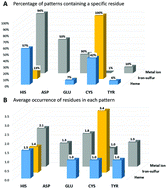The human iron-proteome†
Abstract
Organisms from all kingdoms of life use iron-proteins in a multitude of functional processes. We applied a bioinformatics approach to investigate the human portfolio of iron-proteins. We separated iron-proteins based on the chemical nature of their metal-containing cofactors: individual iron ions, heme cofactors and iron–sulfur clusters. We found that about 2% of human genes encode an iron-protein. Of these, 35% are proteins binding individual iron ions, 48% are heme-binding proteins and 17% are iron–sulfur proteins. More than half of the human iron-proteins have a catalytic function. Indeed, we predict that 6.5% of all human enzymes are iron-dependent. This percentage is quite different for the various enzyme classes. Human oxidoreductases feature the largest fraction of iron-dependent family members (about 37%). The distribution of iron proteins in the various cellular compartments is uneven. In particular, the mitochondrion and the endoplasmic reticulum are enriched in iron-proteins with respect to the average content of the cell. Finally, we observed that genes encoding iron-proteins are more frequently associated to pathologies than the all other human genes on average. The present research provides an extensive overview of iron usage by the human proteome, and highlights several specific features of the physiological role of iron ions in human cells.

- This article is part of the themed collection: Metallomics Recent HOT articles


 Please wait while we load your content...
Please wait while we load your content...